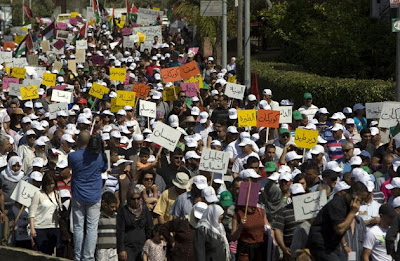[AS
ALWAYS
PLEASE GO TO THE LINK
TO READ GOOD ARTICLES IN
FULL: HELP SHAPE
ALGORITHMS (and
conversations) THAT EMPOWER
DECENCY, DIGNITY, JUSTICE &
PEACE... and hopefully Palestine]
Thousands of Israeli Arabs Thursday marked the "Nakba" or "catastrophe" that accompanied Israel's foundation in a march to where two Arab villages existed before 1948, an AFP journalist said.
Bearing Palestinian flags and banners with names of displaced villages, the procession left Abu Snan in northern Israel for the nearby Kibbutz of Beit Haemek, which was established on the grounds of Kweikat and Omqa villages.
They also bore signs saying "no peace without the right of return," which is claimed by Palestinian communities in the diaspora but rejected by Israel.
It was the fifteenth such march, which each year commemorates different displaced communities.
Ali Ali, who currently lives in
the town of Deir Hanna in the Galilee, told AFP he was from a family
that was displaced near Tiberias. "I'm here to show my solidarity with
all of those displaced from their homes," he said.
To Ahlam Taha,
a woman in her twenties from Kafr Kana, the march was "to commemorate a
very important memory, which is the day we left everything. We are
still suffering the repercussions of this. Their independence is our
Nakba.
"With God's help the day will
come when all the displaced return to their land and have real
independence for Palestine, not Israel."
Israel was on Thursday celebrating the 64th anniversary of its foundation, in accordance with the Hebrew calendar.
Palestinians traditionally mark
on May 15 the "Nakba" when hundreds of thousands of them fled or were
expelled from their homes in the war that accompanied Israel's declaration of independence.
More than 760,000 Palestinians --
estimated today to number 4.7 million with their descendants -- fled or
were driven out of their homes in the Arab-Israeli war which followed
Israel's establishment.
Around 160,000 Palestinians
stayed behind and are now known as Arab Israelis. They number about 1.3
million people, or some 20 percent of the population.










